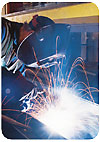
Providing personal protective equipment (PPE) to help protect welders and other employees has always been a top priority in the metal fabricating industry, as well as in other industrial environments. These days, personal protection has been raised to a new level as the impact of safety on a company’s profitability is better understood then ever before.
What was once considered a regulatory expense that should be minimized has now come to be recognized as an investment in cost containment and reduction equivalent to any other cost control program. Today’s safety professionals have a much different PPE agenda and value system than their predecessors. They realize that carefully selected, top-quality PPE can go beyond its primary function of preventing injuries to having a positive impact on loss control, productivity, quality of work life and profitability.
There are various types of PPE needed to safeguard those involved in welding. Having a good understanding of each can help you maximize worker protection while keeping costs under control.
AUTO-DARKENING FILTER LENS
One such PPE product is the auto-darkening filter lens for welding helmets. Introduced in the late ’80s, the ADF lens was greeted with skepticism.Welders were concerned about what would happen if the battery or electronics systems suddenly failed during welding. The ability of the lens to darken fast enough to keep it from being “flashed” was also a concern. At a price greater than $300 when first introduced, ADF lenses appeared to be too fragile to be cost-effective under real-life welding conditions.
Welders who use a helmet equipped with an ADF lens have a good view of work with the helmet in place during positioning and setup. Because the helmet does not need to be lifted up to see, the welder has full protection from others welding in the area. Once the arc is struck, the lens darkens instantly. There is no blind spot or distraction at the crucial start-up point caused by nodding the helmet into the work position. The result is a better, more precise weld that requires less cleanup.
Welding helmets with ADF lenses can help improve the quality of life for welders. By eliminating the need to continuously “nod” a helmet into work position as an arc is struck, strains, sprains and muscle fatigue in the neck and back can be reduced or eliminated.
RESPIRATORS
Respiratory hazards associated with welding fumes remain one of the most serious safety issues facing welders today. Manufacturers have redesigned respirators and filter models specifically to fit and work better under welding helmets.Sizes and shapes were redesigned without sacrificing filtration. Disposable models, in addition to the traditional reusable half-mask respirators, have gained popularity and, more importantly, protect the worker from welding fumes. The wider selection gives welding and safety officials choices that they can provide to welders to make them comfortable.
Employers should follow OSHA guidelines, enlist the services of a certified industrial hygienist to evaluate hazards and concentrations, and assist with fit-testing after an appropriate National Institute of Safety and Health (NIOSH) approved respirator is selected. Suppliers should assist with the required employee training.
PROTECTIVE EYEWEAR
The current ANSI standard requires that protective eyewear be worn at all times under a welding helmet or face shield. Eyewear designed for use under welding helmets has frames and lenses that curve slightly around the temples to eliminate the right angle corners of standard safety glasses. By doing so, the eyewear is not struck by a welding helmet being nodded into place.Most eyewear for welding use has a single, one-piece lens to help maximize the viewing area and make replacement quick and easy. Most are available in clear or filter shades from 2 through 5.
PROTECTIVE CAP COMBINATIONS
In 1994, OSHA issued an advisory that stated “protective caps should not be worn with the peak in the back without consent of the manufacturer.”Wearing a protective cap with the peak in the rear is the best way to combine it with a welding helmet. This combination positions the helmet close to the face and positions the filter plate holder in the proper viewing position. Although the OSHA advisory caused confusion, it forced manufacturers to have caps tested with the peaks to the rear if they were to be used with welding helmets.
Industrial hygienists and safety officials now evaluate the effect that ergonomics has on the neck and back muscles, and on the welder’s posture and working position. They look for balance, stability, adjustability for a comfortable wearing position, proper sizing, and the alignment of the filter plate holder to ensure the welder does not have to stand in a hunched-over manner or assume an awkward welding position to accommodate the protective cap/welding helmet unit.
SOFT CAPS
A less significant product improvement, but an important benefit for welders, is the welder’s “soft” cap. Welder’s soft caps are worn under a welding helmet and occasionally under a face shield to protect the head and hair from direct injury from sparks and spatter. As hairstyles became longer, the common welders’ cap did not provide sufficient coverage.Today, there is a four-panel soft welder’s cap that is bigger, deeper and roomier to cover more head and hair area. The cap can be pulled down over the exposed ear area when welding in the horizontal position, protecting the ear from spatter.
Profit strategy
Today’s “buying decision” is not the purchasing agent’s decision to write the order but, more importantly, the safety official’s decision to incorporate a PPE product into the safety program.The decision-makers usually consist of representatives from the production department to make sure safety is not achieved at the expense of productivity. Industrial hygienists make sure whatever PPE is considered fits right, is ergonomically correct, and can be sanitized and maintained.
Companies have improved their PPE programs and have benefited from them. PPE as a profit strategy is now within every employer’s grasp if expectations are raised, if lessons are learned from previous mistakes, and if a commitment is made to continually stay educated about all possibilities.
Today’s PPE buyer should expect to pay a high price for products and services of a value-adding consulting partner. However, the initial investment will be returned many times over the life-cycle of the products.
A safety official who implements a successful PPE program contributes to his/her company’s bottom line and helps increase the likelihood that his/her co-workers will be able to go home at the end of each day injury-free.





.jpg?t=1721257160)
